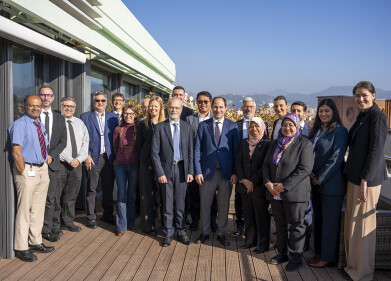Air clean up
The Humble ‘Virtual Chimney’ Fences that could Reduce the Impact of Airport Pollution
Jan 31 2013
Simple ‘blast’ fences called baffles could deliver improvements in air quality for people living near airports, new research has found.
Placed behind a runway, the baffles could serve as a ‘virtual chimney’, funnelling emissions from aircraft engines upwards where they can disperse more effectively, thereby reducing the environmental impact on people living nearby.
Prototype baffles have been tested by a team of researchers from Manchester Metropolitan University, Cranfield University, University of Southampton and the University of Cambridge, with funding from the Engineering and Physical Sciences Research Council (EPSRC).
After preliminary wind tunnel testing of various baffle shapes carried out by Cranfield University, an array of three rows of baffles was tested using laser scanning (Lidar, which is the optical equivalent of Radar) and chemical sensor techniques at Cranfield Airport in Bedfordshire. This demonstrated that the aircraft exhaust plume could be made to leave the ground within the airport’s boundary fence, using prototype baffles of less than a man’s height and constructed out of low-cost agricultural windbreak netting on lightweight frames.
Dr Mike Bennett, who led the project, says: “Airfield surfaces are typically covered with grass, over which the wind can blow freely. An array of baffles makes the surface rough in an aerodynamic sense. This sucks the momentum out of the exhaust jet, allowing its natural buoyancy to come into play. By suitably angling the baffles, we can also give the exhaust an upwards push, encouraging it to rise away from the ground.
“The baffles we tested were tilted at angles between 40° and 60° in order to optimise this vertical flow – and to ensure the baffles didn’t blow over! Although the exhaust will still disperse to the ground eventually, it will do so at a lower concentration. We might hope to see a reduction in surface concentrations of around 50 per cent at the perimeter fence behind the place where aircraft are taking off.”
Long-term ground-level nitrogen dioxide (NO2) concentrations around many major airports in Europe already exceed the legal limit enforced by the EU.
The aim of the trial was essentially to test the baffles’ aerodynamics. As the prototype installation was temporary, it was constructed very differently from how a permanent installation might be made. Each baffle must be sufficiently robust to withstand the 80-90 knot blast from a jet engine, but flimsy enough to collapse harmlessly if an aircraft were to hit it. In the trial, this was achieved by restricting the prototype baffle widths to about two metres but it would be feasible to make them much narrower in a permanent installation. For full-scale use an area of baffles in the order of a thousand square metres would need to be erected behind a runway.
The tests also showed that the baffles dampened engine noise downstream by a modest amount and were helpful in reducing jet blast on the airport perimeter.
“There’s no reason why baffles couldn’t start to be installed at airports within two or three years,” Dr Bennett says. “From the point of view of local air quality, they represent a quick, cheap supplement to developing low-NOx jet engines.”
The project was carried out under the auspices of the EPSRC-funded Airport Energy Technologies Network (AETN), which was established in 2008 to undertake cutting-edge research in the field of aviation.
Events
Carrefour des Gestions Locales de L'eau
Jan 22 2025 Rennes, France
Jan 29 2025 Tokyo, Japan
Feb 05 2025 Nantes, France
Feb 16 2025 Kampala, Uganda
Feb 26 2025 Chennai, India










